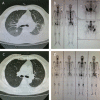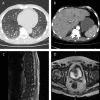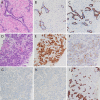Which Way to Choose for the Treatment of Metastatic Prostate Cancer: A Case Report and Literature Review
- PMID: 33981608
- PMCID: PMC8107685
- DOI: 10.3389/fonc.2021.659442
Which Way to Choose for the Treatment of Metastatic Prostate Cancer: A Case Report and Literature Review
Abstract
Background: Prostate cancer (PCa) is the second most common cancer among males in the world and the majority of patients will eventually progress to the metastatic phase. How to choose an effective way for the treatment of metastatic PCa, especially in the later stage of the disease is still confusing. Herein we reported the case of a patient diagnosed with metastatic PCa and conducted a literature review on this issue.
Case presentation: A 57-year-old man with metastatic PCa had been managed by Dr. J.P. since April 2012 when the patient was admitted to the Third Affiliated Hospital of Sun Yat-sen University by aggravating frequent urination and dysuria. The prostate-specific antigen (PSA) concentration was 140 ng/ml, and the diagnosis of PCa was confirmed by prostate biopsy, with Gleason score 4 + 5 = 9. Chest CT and bone scan indicated multiple metastases in the lungs and bones. Triptorelin, bicalutamide, zoledronic acid, and docetaxel were then administered, six cycles later, the metastatic tumors in the lungs disappeared and those in the bones lessened significantly, along with a remarkable reduction in PSA level (< 2 ng/ml). Intermittent androgen deprivation was subsequently conducted until August 2018, when the serum PSA level was found to be 250 ng/ml, again docetaxel 75 mg/m2 was administered immediately but the patient was intolerant this time. Instead, abiraterone was administered until March 2019 because of intolerable gastrointestinal side-effects and increasing PSA level. In October 2019, the patient came to our center, a modified approach of docetaxel (day 1 40 mg/m2 + day 8 35 mg/m2) was administered. Luckily, the PSA level decreased rapidly, the bone pain was greatly relieved, and no obvious side effects occurred. However, four cycles later, docetaxel failed to work anymore, the metastatic tumor in the liver progressed. We proposed several regimens as alternatives, but they were soon denied due to the high prices or unavailability or uncertain effect of the drugs. In addition, the patient's condition deteriorated speedily and can no longer bear any aggressive treatment. Finally, the patient died of multiple organ failure in August 2020.
Conclusion: The experiences of this case provide valuable evidence and reference for the treatment choices of metastatic PCa, in some circumstances modified and advanced regimens may produce unexpected effects.
Keywords: case report; literature review; metastasis; prostate cancer; treatment.
Copyright © 2021 Yang, Jiang, Li, Zhang, Xu, Chen and Pang.
Conflict of interest statement
The authors declare that the research was conducted in the absence of any commercial or financial relationships that could be construed as a potential conflict of interest.
Figures




Similar articles
-
More advantages in detecting bone and soft tissue metastases from prostate cancer using 18F-PSMA PET/CT.Hell J Nucl Med. 2019 Jan-Apr;22(1):6-9. doi: 10.1967/s002449910952. Epub 2019 Mar 7. Hell J Nucl Med. 2019. PMID: 30843003
-
EAU-ESTRO-SIOG Guidelines on Prostate Cancer. Part II: Treatment of Relapsing, Metastatic, and Castration-Resistant Prostate Cancer.Eur Urol. 2017 Apr;71(4):630-642. doi: 10.1016/j.eururo.2016.08.002. Epub 2016 Aug 31. Eur Urol. 2017. PMID: 27591931
-
Complete response with early introduction of cabazitaxel in a patient with multiple lung metastases of castration-resistant prostate cancer following the early detection of metastases using liquid biopsy: a case report.BMC Cancer. 2019 Jun 11;19(1):562. doi: 10.1186/s12885-019-5782-2. BMC Cancer. 2019. PMID: 31185946 Free PMC article.
-
Prostate Cancer Detected by Choroidal Tumor and Complete Response to Hormonal Therapy: Case Report and Literature Review of 24 Patients With Choroidal Metastasis From Prostate Cancer.J Investig Med High Impact Case Rep. 2021 Jan-Dec;9:23247096211026471. doi: 10.1177/23247096211026471. J Investig Med High Impact Case Rep. 2021. PMID: 34159819 Free PMC article. Review.
-
EAU guidelines on prostate cancer. Part II: Treatment of advanced, relapsing, and castration-resistant prostate cancer.Eur Urol. 2011 Apr;59(4):572-83. doi: 10.1016/j.eururo.2011.01.025. Epub 2011 Jan 25. Eur Urol. 2011. PMID: 21315502
References
-
- Adams J. The Case of Scirrhous of the Prostate Gland With Corresponding Affliction of the Lymphatic Glands in the Lumbar Region and in the Pelvis. Lancet (1853) 1(1):393–3. 10.1016/S0140-6736(02)68759-8 - DOI
Publication types
LinkOut - more resources
Full Text Sources
Research Materials
Miscellaneous

